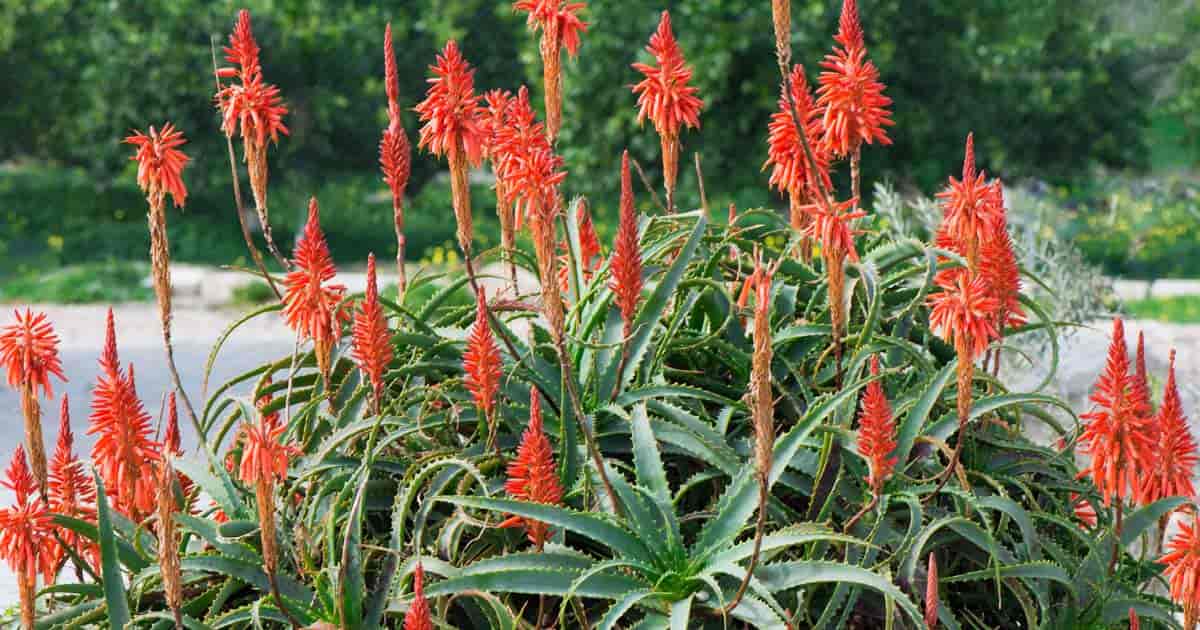Aloe Arborescens [aL-oh ar-bo-RES-senz], commonly known as the Candelabra plant.
It is an evergreen perennial succulent from the Asphodelaceae family and Aloe genus.

The name comes from the plants’ ability to grow as a small tree.
The Latin word arborescens means ‘tree-like.’ The name aloe comes from the Greek alsos referring to the bitter juice of the plant leaves.
The Candelabra Aloe goes by several other common names:
- Krantz Aloe
- Mountain Bush Aloe
- Tree Aloe
- Octopus Plant
- Torch Plant
- Torch Aloe
It is a cousin of the widely popular Aloe Vera plant and shares a similar history. It rose to popularity in the 1700s when plants from the South African cape were brought into Europe for the wealthy.
It was initially intended as a medicinal plant to help heal burns, but its popularity as a houseplant grew due to its easy cultivation and attractive appearance.

The plant is native to the countries of South Africa, Malawi, Mozambique, and Zimbabwe.
Unlike other Aloe species, the plant has a varied habitat and grows from sea level up to the cliff edges on rocky mountains.
More Interesting Aloe Plants:
- Aloe Aristata (Lace Aloe)
- Aloe Variegata (Partridge-breast aloe)
- Spiral Aloe (Aloe polyphylla)
- Aloe marlothii (Mountain Aloe)
Candelabra plants can live for years and are in season all year long which makes them a popular choice for houseplants – and also one of the easiest!
Arborescens Aloe Plant Care
FACT: A. arborescens is the most widely distributed of all the South African Aloes where it’s range is beyond 1,000 miles. It occurs at sea level in full sun to the first mountain ranges [source: The Aloes of South Africa – pg. 409]

Size and Growth
The Aloe candelabra plant is a fast-growing plant and grows both as a window plant and as a floor plant if it outgrows its old spot.
The size of the plant varies. Some grow to over 5′ feet tall with rosettes around 18″ inches wide if given the right growing conditions and space.

Once the plant outgrows the windowsill, it will need moving to a bigger spot as a floor plant.
However, to keep the plant small, prune branches at the risk of affecting the overall shape of the plant.
Flowering and Fragrance
The Candelabra plant is characterized by large sprawling, thick leaves.
These can be green, yellowish or bluish-green. These leaves are lined by small spotted leaves taking the shape of tiny teeth.

In the perfect growing conditions, the plant produces trumpet-shaped scarlet flowers giving off a slight scent. However, this is rare.
Light and Temperature
This light loving plant and needs an area where it gets plenty of sunlight. It does not need protection from direct or full intensity of the sun. It does well with full sun.
It is sensitive to frost and colder temperatures. Keep temperatures above 40° degrees Fahrenheit. This plant is ideal for USDA hardiness zones 9b to 11b.
Watering and Feeding
Water Candelabra plants in the summer at regular intervals. However, allow the soil to dry between the watering.
During the drier winter months, water 2 to 3 times a month – enough to keep the soil moist. It tolerates moderate levels of drought.

Fertilize with a liquid food once a month. The plants do not fertilizer during the winter.
Soil and Transplanting
Because the plant is a fast-growing, sprawling plant, it requires soil and pots to match the demands of its growth. A well-drained, commercial cactus mix is preferable.
However, make your own mix by combining equal parts of sand, perlite, and potting soil. Add gravel to this mix for drainage in the base, and you’re good to go! More on soil for Aloe plants.

The plant grows in smaller pots while young but will outgrow its space and will need stepping up to a larger container once it matures.
This is best done during the summertime. When growing outdoors bring the plant back indoors during the fall and winter months.
Grooming and Maintenance
In general, the plant does not require a lot of maintenance.
However, when leaves wither and the tips turn a shade of red, it means the plant is not getting enough water which puts the plant under stress.

NOTE: Aloe Cameronii known as the Red Aloe naturally turns a brick or orange-red.
Make sure not to let the soil dry out.
If you choose to grow the plant like a small tree, remove the side shoots to encourage erect growth. This helps to rejuvenate older plants.
Related Reading: Growing Red Hot Poker Plant – Care Tips For Kniphofia
How To Propagate Candelabra Aloe
Candelabra propagates easily during spring from sideshoots and cuttings. Remove the lower leaves and allow the cutting to dry before placing the cutting in small pots filled with cactus soil.

Water the soil sparingly. Too much water can cause the cutting to rot.
Candelabra Arborescens Pest or Disease Problems
This plant is often subject to leaf fungus disease characterized by black spots on the leaves.
In order to combat the infection, move the plant to a sunny spot with less humidity.

Be careful of how much you water. Be on the safe side, water less!
Often, mealybugs and scale insects appear along the leaves, but these are easily controlled.
Remove the insects by wiping off the surface using a cloth dipped in alcohol.
Suggested Uses Of Candelabra Aloe
Use the plant as a decorative and medicinal plant. It is a great option to grow indoors as a floor plant or outdoors in full sun as a thicker shrub or barrier plant.

The sap from the leaves helps to relieve burns and wounds. Use the Candelabra plant for its medicinal capacity due to its antibacterial and anti-inflammatory nature.